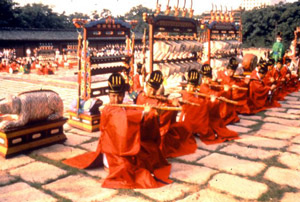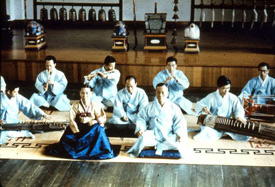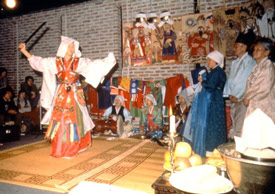Korean Traditional Music Lecture |
Korean traditional music lectures by Jin Hi Kim have been successfully presented at over 200 universities in the USA including Wesleyan University, Cornell University, Yale University, Duke University, Indiana University, Peabody Conservatory, New England Conservatory, California Institute of the Arts, University of Minnesota, University of California San Diego, and University of Michigan. Prof. Kim was the Freeman Artist–In–Residence at Cornell University for the fall semester 2004, for which she gave a course entitled, “Korean Music in a Global Context”. Kim teaches "Korean Drumming and Creative Music" at Wesleyan University.
Booking Korean Traditional Music Lecture & Concert (PDF)
|
Jin Hi Kim with Korean barrel drums © David Ryan |
Korean Music
Korean traditional music has been evolving for over 2000 years, and it is now rapidly moving in many directions with contemporary life and influence from Western culture.
Traditional Korean music has three basic styles: court music, folk music, and ritual music (Confucianism. Buddhism and Shamanism). Within each of these areas there was a great deal of variety including vocal music, various size ensembles, drumming groups, and solo music. Historically Korean music was integrated with dance, literature, art, song and ceremony. Therefore, music (sound) was not separated from other elements.
It is common that most Korean musicians play the drum, because the traditional music based on various janggo rhythmic cycle (jandan). The most popular percussion ensemble, samulnori is a drum quartet which was originated from farmers percussion band nong-ak (poongmul-nori). The farmers band performed for ancestor's worship ritual as well as celebration of life. A barrel drum set consisting of three to five highly ornate suspended barrel drums are used in Korean traditional dance pieces, in which dancers also play the drums with vigorous rhythmic patterns. A drum solo is derived from the Buddhist monk's drumming on a large barrel drum for meditation and enlightenment. It is important to understand Korean elastic time sensibility that the rhythmic patterns are savory of dance rather than absolute time frames.
A revolution of Korean music occurred, when two new forms were created: Pansori, an epic drama song (late 18th Century) and Sanjo, a solo improvisatory instrumental form (late 19th century). Finally, through these new solo forms, the individual expressivity and freedom in Korean music began to be recognized. This was a dramatic change in a culture that valued group activity and to a large degree suppressed individuality. This emerging improvising legacy was similar to early American jazz.
Korean Music was severely impacted during the Japanese occupation (1910-1945) and subsequently by the Korean War. During the Japanese occupation the Korean Yi dynasty court was completely demolished and leading master musicians lost their freedom. After the Korean War, European classical music was fondly embraced and began to overpower the ancient Korean music. In the 1970's, influenced by the Western classical orchestra music, a new direction for the traditional Korean music orchestra emerged and became a sensation with audiences.
Meanwhile the National Gugak Center (former National Center for Korean Traditional Performing Arts) in Seoul worked to preserve the late 19th century Yi dynasty court and folk music and dance. Fortunately, this repertoire still can be heard and seen today. There are many universities that teach Korean traditional music in Korea. National Gugak Center has been touring traditional performing arts worldwide with support from the government, foundations and corporations. Over the years, many great performances have been presented throughout the United States with leading virtuosi.

|
Jongmyo Shrine Ceremony |
|
Despite the promotion of Korean traditional music on national radio and TV broadcasting, newly created Korean ensembles and bands are successfully beginning to dominate the national music scene. In 21st century, as the society changes Korean music is changing also with differing values of popular culture brought in through recordings, film, and of course the internet. Young musicians go beyond the traditional music and are developing a new repertoire that mixes Western instruments or electronics with various traditional instruments. In contrast to the past, as Korea has entered into instant global communication, more individual music is constantly produced in various art forms.
Komungo (Geomungo)
In the 4th century in Koguryo (ancient Korea) Wang San Ak built a new string instrument based on a seven stringed instrument from Jin China. A black crane (bird of sky) flew to the instrument when he played his new composition on it. So it was named the 'black crane zither'. Later it was called komungo meaning black zither. The komungo is a fretted board zither indigenous to Korea. On the wall painting of the Koguryo Kingdom tomb, komungo has 4 strings and 17 frets that was played by a female. Also shown is a dancer accompanied by a trio of a komungo, a moon lute and a vertical bamboo flute. The current komungo has 6 strings and 16 frets on a six feet board. The strings are made of twisted silk, which are plucked and stoke with a bamboo stick.
Under centuries of Confucianism komungo was known as male instrument and performed by male Confucian scholars for their meditation. It has always been the primary instrument in aristocratic lyric song kagok ensemble (poongryu akdan) and court orchestra. Approximately one hundred years ago two styles of komungo sanjo, derived from Shamanistic music tradition, were improvised with a series of rhythmic cycles by Sin Kwe-dong and Han Gap-duk. This sanjo is the first and only significant komungo solo repertoire.
 |
 |
| Kagok Lyric Song Ensemble |
Shaman Ritural Kut |
Jin Hi Kim, a renowned innovative komungo virtuoso and a Guggenheim Fellow composer, has devoted her life to introducing Korean music outside of Korea. Kim’s komungo solo music is deeply rooted in Korean tradition and represents an evolution of the instrument into the twenty first century. Kim brings an expanded instrumental vocabulary to classical Western performances with the inclusion of Korean instruments within the Western ensembles and herself as soloist.
The international awareness of Korean music in the past thirty years has arguably been in part due to the world-wide touring, performing and appearances of Jin Hi Kim. She has brought a deeper understanding of the universality of Korean music through her relentless work around the world. Jin Hi Kim has performed on main stages world-wide including Carnegie Hall, Lincoln Center, Kennedy Center (Washington DC), Smithsonian Freer Gallery of Art, Royal Festival Hall (London), Haus der Kulturen der Welt (Berlin), and various international festivals.
Korean Drumming Workshop
Wesleyan University Korean Drumming
& Creative Music Ensemble
|